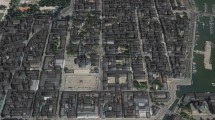Abstract
In this paper, we have investigated the impact of rainfall of different intensities on cellular systems with millimeter waves in concrete environments. The data of specific areas are map-based, obtained from openstreetmap.org, and consist of variable degrees of urban and infrastructural developments. In this case, the results of losses in the propagation of millimeter waves, obtained by the ray-tracing imaging method, are compared with those given by Recommendation ITU-R P.838. The results show significant differences, with increased losses in the map-based channel model scenario concerning the data provided by the relevant recommendation. The increased distance between the transmitter and the receivers showed even more significant differences in the results of the simulated scenarios compared to the ITU-R P.838. The paper presents the research results on the frequency 28 and 38 GHz, but comparable results were for other frequencies of millimeter waves, like 68 and 73 GHz.









Similar content being viewed by others
REFERENCES
I. Shayea, T. Abd. Rahman, M. Hadri Azmi, and A. Arsad, “Rain attenuation of millimeter-wave above 10 GHz for terrestrial links in tropical regions,” Trans. Emerging Telecommun. Technol. 29 (8), e3450 (2018).
P. Kantor, A. Drozdy, and J. Bito, “Effects of rain fading in ad-hoc microwave 5G mesh networks,” In10th IC1004 MC and Scientific Meeting, May 2014.
A. A. Budalal, M. R. Islam, and K. Abdullah, and T. A. Rahman, “Modification of distance factor in rain attenuation prediction for short-range millimeter-wave links,” IEEE Antennas Wireless Propag. Lett. 19 (6), 1027–1031 (2020).
M. H. Azmi, M. Cheffena, A. Al-saman, M. Mohamed, and Y. Ai, Statistical Analysis of Rain at Millimeter Waves in Tropical Area, IEEE Access.
https://doi.org/10.1109/ACCESS.2020.2979683, 8, pp. 51044–51061 (2020).
Radiocommunication Sector of International Telecommunication Union, Recommendation ITU-R P.838-3: Specific attenuation model for rain for use in prediction methods, 2005.
H. Zhao, R. Mayzus, S. Sun, M. Samimi, J. K. Schulz, Y. Azar, K. Wang, G. N. Wong, F. Gutierrez, and T. S. Rappaport, “28 GHz millimeter wave cellular communication measurements for reflection and penetration loss in and around buildings in New York city,” in 2013 IEEE Int. Conference on Communications (ICC) (IEEE, 2013), pp. 5163–5167).
J. F. Monserrat, S. Inca, J. Calabuig, and D. Martín-Sacristán, “Map-based channel model for urban macrocell propagation scenarios,” Int. J. Antennas Propag. (2015).
A. Osseiran, F. Boccardi, V. Braun, K. Kusume, P. Marsch, M. Maternia, O. Queseth, S. M. Schellmann, H. Schotten, H. Taoka, and H. Tullberg, “Scenarios for 5G mobile and wireless communications: The vision of the METIS project,” IEEE Commun. Mag. 52 (5), 26–35 (2014).
E. Regonesi, L. Luini, and C. Riva, “Limitations of the ITU-R P. 838-3 model for rain specific attenuation,” in 2019 13th European Conference on Antennas and Propagation (EuCAP) (IEEE, 2019), pp. 1–4.
Z. Yun and M. F. Iskander, “Ray tracing for radio propagation modeling: Principles and applications,” IEEE Access. 3, 1089–100 (2015).
H. T. da Silva, M. S. de Alencar, and K. D. Assis, “Path loss and delay spread characterization in a 26 GHz mm-wave channel using the ray-tracing method,” in 2019 SBMO/IEEE MTT-S International Microwave and Optoelectronics Conference (IMOC) (IEEE, 2019), pp. 1–3.
A. Y. Hsiao, C. F. Yang, T. S. Wang, I. Lin, and W. J. Liao, “Ray tracing simulations for millimeter-wave propagation in 5G wireless communications,” in 2017 IEEE International Symposium on Antennas and Propagation and USNC/URSI National Radio Science Meeting (IEEE, 2017), pp. 1901–1902.
V. Degli-Esposti, “Ray Tracing propagation modeling: Prospects,” The 8th European Conference on Antennas and Propagation (EuCAP) (IEEE, 2014), pp. 2232–2232.
https://de.mathworks.com/.
Author information
Authors and Affiliations
Corresponding authors
Ethics declarations
The authors declare that they have no conflicts of interest.
Rights and permissions
About this article
Cite this article
Hamiti, E., Gegaj, K. Study of Rain Attenuation Effects for 5G mm Wave Cellular Communications in Real Scenarios. J. Commun. Technol. Electron. 66 (Suppl 2), S109–S117 (2021). https://doi.org/10.1134/S1064226921140059
Received:
Revised:
Accepted:
Published:
Issue Date:
DOI: https://doi.org/10.1134/S1064226921140059




